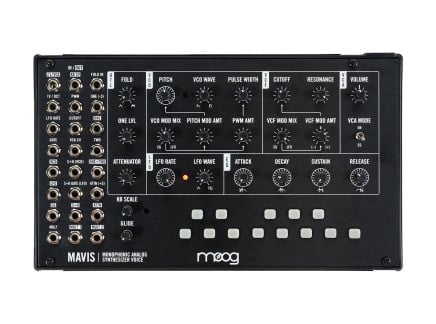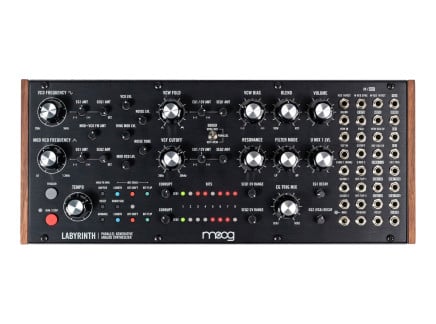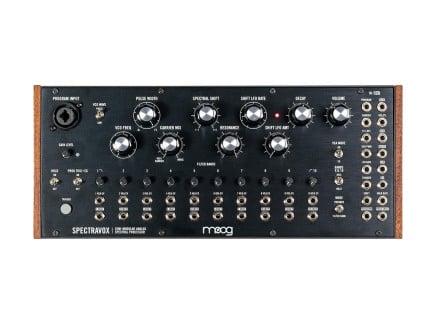Moog's foundational position in the world of synthesis is well-known: Dr. Robert (Bob) Moog was, of course, one of the first creators of a modular synthesizer system, developing his original synthesizers in the 1960s. Since then, the company Moog (in its various iterations) has worked to popularize the synthesizer as an instrument altogether—collaborating closely with musicians of all styles to create devices that met both their technical and their musical demands. And that's part of what made Moog's inventions so special: they weren't just designing machines...they were designing tools that expanded a musician's capacity for expression.
Today, Moog Music, Inc. still makes some of the most interesting musical devices available—and as of the last few years, they have quite visibly returned to their roots in modular synthesis. Of course, they've produced limited reproductions of some of their iconic vintage 1960s modular systems, but they've also introduced a series of affordable and approachable instruments directly inspired by their modular predecessors. Let's take a look at Moog's step back into modular synthesis, with a focus on their popular line of desktop semi-modular synthesizers: the Mavis, Mother-32, DFAM, Subharmonicon, Labyrinth, and Spectravox.
Moog & the Modular Explosion
Once Eurorack modular synths really started to pick up steam in the early 2010s, it was only natural for all of us to ask: "Why isn't Moog making modular synthesizers?" The modular-inspired, CV-heavy Moogerfooger effect pedal line was still in production, and all of Moog's analog keyboard synths employed CV and Gate connections. And of course, being a brand that inherited the legacy of one of the world's first modular synth makers, it felt obvious that Moog Music, Inc. should take a step in this direction.
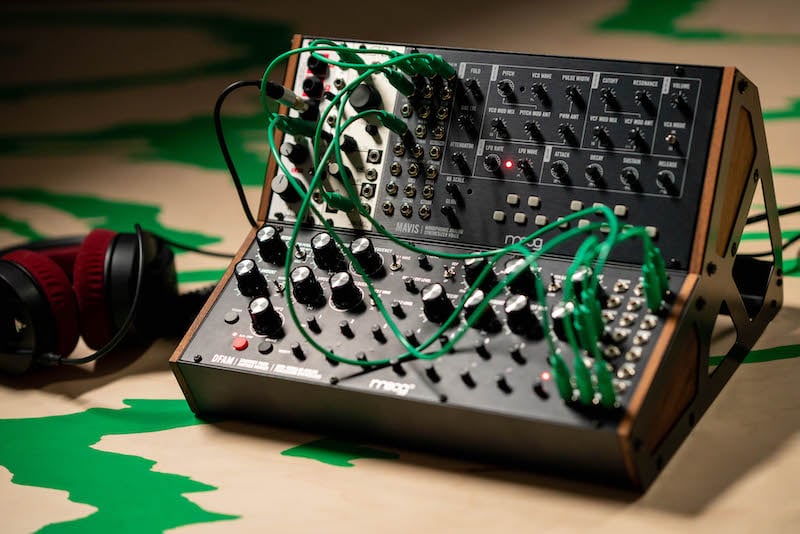
As time would have it, we didn't really have to wait for long. Today, we find ourself in a world with semi-modular Moog keyboard synths like the Grandmother and Matriarch, along with four readily available Eurorack-friendly desktop synthesizers—Mavis, Mother-32, DFAM, Subharmonicon, and the most recent entries to the family: Labyrinth and Spectravox. This family of desktop synths in particular represent, for me, one of the most significant developments in commercial synth design this decade: affordable, high-quality, compact desktop-format semi-modular instruments produced by a long-established and highly-revered company. This modern archetype in synth design is perfect for musicians coming from all angles: it's a way for modular synthesists to add the real Moog sound into their setups, sure, but it's also a way for keyboardists and young musicians to dip their toes into the flexible and alluring world of modular synthesis with a brand that they know they can trust and a sound that they know will fit into their music.
From the perspective of a modular-focused retailer, these Moog synths are a spectacular way to get started with modular synthesis. Experienced musicians and complete newcomers often come our way knowing that they want to dive into the modular workflow—and often, they know that they want to start out with a Moog. Since these synths are fully Eurorack-compatible (in fact, you can even remove them from their dedicated cases and mount them in a Eurorack case), they can act as an immediate bridge into this unfamiliar world—and due to their semi-modular nature, it's easy to get them up and running in a musical application. But the big question then emerges: Which one should I choose?
Let's take a look at each of these six synthesizers and point out what makes each so special—perhaps looking things over, you'll start to understand which one is right for you.
Moog Mavis: the Ultimate Beginner Synthesizer
The newest and most affordable member of Moog's family of compact semi-modular synthesizers, Mavis would no doubt make an excellent first step for anyone looking to dip their toes into the deep waters of modular synthesis. With all the components you need to make everything from classic synth tones to completely out-there experimental sounds, it's an excellent playground for sonic experimentation. In my opinion, that makes it an excellent tool for learning, as well.
Mavis ships as a simple "kit" that you assemble yourself—but there's no soldering required, and all the tools you need to put it together are included in the box. By all accounts, it's a quite easy build that you can handle yourself, even if you don't have any prior experience with synth kits or DIY electronics.
So, let's get down to what Mavis actually is, and what it contains. First off, Mavis is a monophonic analog synth voice based on the architecture of many classic Moog instruments. It features an analog oscillator (VCO), the classic Moog transistor ladder low pass filter (VCF), and a VCA for controlling the sound's loudness. You have a low frequency oscillator (LFO) for adding movement to your sound, and an envelope generator (EG) for shaping articulations and one-shot modulation effects. A simple built-in keyboard is available for playing melodies, bass lines, or even acting as a modulation source.
All of these submodules have internal normalled connections behind the panel, arranged in such a way that it's quite easy to get to a wide range of synth sounds without even needing to use the patch bay. But truly, the patch bay is where things get particularly interesting: it provides access to a lot of tricks you can't quite achieve through the panel controls alone. Perhaps the most obvious is the inclusion of a wavefolder...a type of tone-shaping circuit typical of 1970s instruments made by instrument designer Don Buchla. Notably, this is the first Moog instrument to ever include a wavefolder; because this type of sound-shaping has become so common in the Eurorack modular synth universe, it's exciting to see Moog bringing it into this new instrument.
The patch bay also includes several voltage utilities, including a DC-coupled mixer, patchable attenuator, signal multiple, and even a Sample + Hold circuit...something notably absent from all of the other Moog semi-modular designs. All in all, these make Mavis a highly patchable instrument—one whose behavior can be pushed into a huge range of directions, and which provides an astonishing level of flexibility given its size and its price. This means that it would certainly pair well with any other modular system, or even other Moog semi-modular synths...but at the same time, it would prove to be quite fertile territory for those looking to get started with patchable synthesizers altogether. There's a lot to explore.
I'll note that Mavis does lack a couple of niceties found in some of the instruments we'll discuss below; most notably, it doesn't include MIDI input or a built-in sequencer. For some, this may be a significant downside. However, there's nothing stopping you from using it with an external controller: an Arturia Keystep, Korg SQ-1, or Make Noise 0-CTRL could make an excellent pairing. Furthermore, it can be used with MIDI-CV converters as well, so if you feel you need a more flexible control source or easier DAW integration down the road, it's possible to achieve. In fact, Mavis, like Moog's other semi-modular instruments, can even be removed from its own enclosure and placed into a Eurorack system. So, while it might seem to lack features important to some musicians, it's easy to expand and fit into any setup with the right amount of thought.
Moog Mother-32: Bass and Lead Machine
The original entry into Moog's desktop semi-modular family, the Mother-32 is modeled after the workflow of a classic Moog subtractive monosynth. It's a great choice for musicians looking for a classic Moog synth voice for making heavy-hitting basslines or soaring leads, with everything a complete instrument needs built right in.
Mother-32's analog signal architecture includes a saw/pulse oscillator, an internal noise source, a switchable highpass/lowpass filter, a VCA, a dedicated LFO, and an AR envelope generator. With options for portamento, pulse width modulation, and FM from the internal LFO and envelope, the single oscillator can produce an astounding and staggering range of rich, heavy raw tones. Of course, much of the magic of a Moog instrument is what happen next: the filter. The Mother-32's filter can process a blend of the internal oscillator and noise or external signals, and imparts a distinct sonic character on everything that comes through it. Using Moog's famous transistor ladder design, this circuit imparts a warmth and presence that in some ways put Moog on the map. When you turn that cutoff knob, you'll instantly say, "Oh—that's the sound I've been hearing all my life." Add some resonance and you're in a land of squelchy sweeps; crank it up all the way, and the filter can even self-oscillate, acting as a secondary sound source perfect for combining with the oscillator itself. The filter can also operate in both lowpass and highpass modes for additional sonic opportunities.
While there are dedicated internal modulation routings from the envelope and LFO to the oscillator and filter respectively, one of the other key features of the Mother-32 is its 32-point patch bay. Because the Mother-32 is semi-modular, you don't necessarily need to make use of the patch bay in order to get it creating sound: it has a normalled internal signal path which will cover your bases for a huge range of classic synth sounds. However, for those curious about experimenting with modular synthesis, the patch bay is a portal to a whole new world of interaction—a world where any signal can affect any other part of the instrument, and completely new ways of playing the instrument can be discovered.
The dedicated DIN MIDI input makes the Mother-32 a breeze to integrate into DAW and keyboard-based workflows...simply add a MIDI control source and you've got a Moog monosynth for a heck of a price. Or, for those interested in sequencing, there's a built-in keyboard-driven sequencer governed by the set of buttons toward the bottom of the panel. Capable of up to 64-step sequences with loads of options for on-the-fly variation, this turns the Mother-32 into a truly self-sufficient instrument. So even if you don't have a studio full of gear—even if you're looking for your first piece of music hardware altogether, it's hard to go wrong with the Mother-32.
Moog DFAM: Drum Synth + Sequencer
Of course, there can be more to life than classic analog synth basses and leads. For many, one of the most exciting aspects of electronic music is about exploring the intersection of sound and rhythm, without a need to focus heavily on melody. There's a whole universe of possibilities where melody takes a back seat to these other parameters...a universe where shifting rhythms and variations in tone color come to the forefront. For those exploring analog synth sound design with a strong focus on rhythm—or for folks just looking for an analog drum synth and sequenced bass machine...you're going to love the DFAM.
The DFAM (or Drummer From Another Mother) is, at its heart, a drum synthesizer based on a built-in two-track, eight-step sequencer. Like the Mother-32, it features the classic Moog resonant transistor ladder filter. Sonically, one of the most significant ways in which the DFAM differs from the M-32 is in its oscillator section. While the M-32 has only one dedicated oscillator, DFAM has two—and that provides a huge range of sonic opportunities not possible in the M-32. One of the most notable is that the DFAM makes strong use of oscillator FM and hard sync—which, especially when used in combination, can range from subtle effects to edgy, grating drones. In addition to FM, the oscillators can be modulated via the integrated envelopes as well, providing easy access to classic analog tom and kick-style tones. Each oscillator can produce triangle or square waves...and while there's no provision for PWM, the FM and Sync options will keep you discovering new timbres for ages.
The DFAM's true core, though, is the 8-step sequencer. It has two tracks, one normalled to oscillator pitch (which can be routed to either, both, or neither oscillator via a dedicated switch), and the other normalled to "velocity," which controls an internal VCA for creating dynamically shifting sequences. Of course, the built-in decay-only envelopes for filter frequency and loudness have voltage-controllable duration, the FM amount is voltage-controllable, and each sequencer track has a dedicated CV output—so there's no end to the number of ways you can create interesting tones and rhythms. There's no MIDI on the DFAM, so syncing it to your DAW can take a couple of extra steps beyond what the Mother-32 can do....but of course, like the Mother-32, it can be easily integrated with Eurorack gear or other CV-capable desktop synths.
Moog Subharmonicon: Subharmonic Playground
Moog's next semi-modular synth is the Subharmonicon. For some, the Mother-32 and DFAM cover all the bases: bass lines, melodies, rhythms, textural sequences. But the Subharmonicon takes a significantly different conceptual approach. It isn't necessarily about fitting into normal musical frameworks: instead, it is about experimenting with time and harmony, and discovering results that might not normally occur to you.
Subharmonicon deviates significantly from the typical synthesizer workflow. It does contain two analog oscillators and the expected Moog lowpass filter...but where it gets peculiar is in its suboscillators and its sequencer. Each of the two oscillators has two dedicated suboscillators which can be tuned to any frequency division from /1 to /16—meaning that Subharmonicon provides easy access to tones and harmonies derived from the subharmonic series.
This can lead to some striking results, since these tones don't conform to the typical 12-tone equal tempered tuning system. The end product are "perfect" harmonies based on mathematical ratios, which can make it clear that the gradient between "consonant" and "dissonant" is quite varied. Between the two oscillators and each of their two suboscillators, you can create up to six-note harmonies, making Subharmonicon a perfect tool for exploring harmonically-centered ambient textures and soundscapes.
The sequencing section is similarly peculiar: it features two four-step sequencers, each which corresponds to one of the oscillator sections. The sequence may be sent directly to the oscillators' pitches (with multiple quantization options), or alternatively could be used as a control for their suboscillators' frequency subdivisions, enabling access to pseudo-quantized, chiptune-like melodies and harmonies. What's even more peculiar, though, is the rhythm generation: much like the suboscillators themselves, the sequencers are driven from four clock dividers which share a common master tempo. You can assign each of the four clock dividers to either of the four sequencers in any combination, making for highly unpredictable, evolving rhythmic structures.
Subharmonicon does offer MIDI input via 3.5mm jack, and offers the same style patchbay as in the DFAM and Mother-32. You might be wondering, though, how can such a peculiar synth really fit into my workflow? The answer, I think, is that Subharmonicon is a synth better suited to exploration than to task-based music-making...at least until you get a handle on everything it can do. If you're interested in tinkering and exploring new musical concepts, Subharmonicon is a playground of exploration, one which rewards patience and careful listening. Through slow and patient exploration, you'll come to realize that Subharmonicon is a synth unlike any other, and that it will take you into musical corners that you've never imagined.
Moog Labyrinth: Experimental Generative Synthesizer
For those seeking an even more experimentally-leaning approach, take a look at Labyrinth. Described by Moog as a "parallel generative analog synthesizer," Labyrinth takes inspiration from esoteric 1970s synthesizers and aleatoric music practices to produce an instrument that, in its best moments, can surprise and inspire its user to head into unexpected musical directions. Labyrinth is quite different from its siblings in two primary ways: in its approach to sound generation/shaping, and in its approach to sequencing.
Labyrinth's audio structure is unlike any Moog instrument before it. Foregoing harmonically-rich oscillator waveforms and a transistor ladder filter, it instead relies on simple waveforms, wavefolding, and a 12dB/multi-mode filter to generate sonic interest. Labyrinth's two oscillators produce sine and triangle waves, respectively; by using linear thru-zero frequency modulation and ring modulation, one can wrench these into all manner of complex, peculiar, inharmonic, or subtly evolving tones. The sine wave oscillator acts as a primary audio source, while the secondary triangle oscillator is designed to act primarily as a modulation source, reaching downward well into low frequency territory (though it can, of course, still be used in the audio range as a sound source, as well!). The built-in noise source offers a continuously variable color control—and the mixer section offers plenty of opportunity for saturation, imparting a pleasant distortion onto your basic tones.
From their, the signal path bifurcates: passing sound along to the wavefolder and filter sections. These two processors may be arranged in series (in either order) or in parallel; a voltage-controllable Blend parameter allows you to continuously balance between the output of each of these sections.
The wavefolder offers variable fold amount and bias controls, providing continuously variable access to a huge range of novel waveshapes reminiscent of cult classic instruments by Don Buchla. The fold amount is voltage-controllable, offering internal normalled connections from a built-in envelope and sequencer, as well as a patch point on the patch bay. The filter is a multi-mode filter, with a blend control offering continuous fading between lowpass and bandpass modes. It also offers continuously variable resonance. This 12dB/octave filter is much gritter than the typical Moog ladder filter, imparting a strong sonic character on your heavily modulated or wavefolded tones. Each of these pass into their own dedicated VCAs; the second envelope generator is normalled to these VCAs for easy, simple, sequenced articulations, but of course, any signal can be patched to control their loudness.
Labyrinth's sequencer is the other piece of the puzzle, holding the key to its "generative" capabilities. At its core, the Labyrinth sequencer is truly two eight-step sequencers, each of which is controlled by the internal clock by default, and each of which offers an identical set of features (but a different set of normalled destinations, and separate clock inputs and CV outputs on the main panel). Unlike the Mother-32 or DFAM sequencers, these sequencers' outputs can only be partly controlled: while it is possible to define specific rhythms, the outgoing correlated control voltages are always determined randomly. Happily, the outputs can be quantized to any of sixteen built-in scales, keeping things melodic for those who want it that way.
The Corrupt parameter on each sequencer is a primary point of interest. With Corrupt turned all the way down, Labyrinth's sequencers produce exactly the same CV/gate pattern on each repeat. Turning Corrupt up toward noon, you introduce likelihood that the control voltages associated with the current gate pattern will change on any given repeat. Turning Corrupt up even farther, you increase the probability that the gate pattern will change—until complete randomness at its maximum value. This provides a variety of ways to build sequences that gradually change over time...or that change constantly before your eyes. Of course, there's much more to the sequencers than just that: they can have different number of steps, they can be chained, they can be offset from one another, and much more.
Labyrinth also includes a 3.5mm MIDI input for use with external controllers. Its patch bay offers a ton of potential for interfacing with other semi-modular or modular gear...with more patch points than on any of its siblings. These patch points relate to everything from the sound structure, built-in modulation sources, and even the ability to program the sequencers from external signals. Ultimately, Labyrinth presents its own idiosyncratic approach to music-making: one that leverages a unique combination of uncertainty and complex generative processes to make music and sounds that surprise you and take your music to unexpected places.
Moog Spectravox: Analog Spectral Processor
The instruments we've described so far make an ideal entry point into the world of modular synthesis: each of them combines a powerful and flexible sound generation structure with some means of live keyboard control and/or sequencing. In that way, each of them feels like a "complete package," making it easy to get started making music without the need for any other gear. In this sense, the other member of the family—Spectravox—might seem a bit strange. While it is no doubt an excellent tool, it is not quite as self-sufficient as Moog's other semi-modular offerings, and benefits from external microphones, sound sources, and other modular or semi-modular equipment.
Spectravox is an analog spectral processor, designed primarily to process external signals through a beautiful-sounding 10-band filter bank. However, it does feature an internal carrier oscillator, which produces saw or pulse waveforms (with continuously variable pulse width). Without an external signal, it's still possible to process this internal oscillator through the filter bank.
The filter bank itself is a combination of ten resonant filters: one lowpass, eight bandpass, and one highpass. Each responds to a macro Shift parameter (which controls their cutoff frequencies in tandem), a global Resonance control, and ten individual level controls (which may act as VCAs, allowing you to modulate individual filter level controls from external sources). With this combination of features, the instrument can achieve a surprising number of tones: phaser-like sweeps, formant filtering effects, resonator-like tones, and much more. This style of processing can be applied to external signals by patching into the carrier input on the patch bay as well, imparting colorful analog spectral processing onto any sound you desire.
Of course, one of Spectravox's most evocative capabilities: it can be used as a ten-band vocoder. By using the front-panel program input (on XLR-1/4" combo connection or the 3.5mm input on the patch bay), you can send an external into a bank of "analysis" filters, which collectively produce a set of ten envelope follower signals (all accessible on the front panel). By switching into "vocoder" mode, you can pre-patch these ten envelope follower signals to the CV inputs of the individual filter VCAs, creating a simple-yet-effective vocoder. Using a microphone and the internal oscillator, you can create classic robotic voice-like effects; but of course, you can plug any signal into the program and carrier inputs for colorful and experimental vocoding tricks. You could even use the patching capability to "scramble" the spectrum by reassigning envelope follower output/VCA input pairs: the possibilities are quite open-ended.
Spectravox isn't exactly a general-purpose instrument, and as such, might not make sense for most musicians' first step into analog modular synthesizers. However, it is a beautiful-sounding, peculiar, and remarkably fun tool, and would make a great addition to practically any existing modular or semi-modular setup; and indeed, it might be my personal favorite of the bunch. Note, however, that it is not MIDI-capable, and that it has no internal sequencing or keyboard. It truly is primarily an audio processor/effect, and while it can certainly make sound on its own, its control feature set is not oriented toward the same type of instant musical gratification as are its siblings.
So...Which One is Best for Me?
So, you may be asking...which of these synths makes most sense for me? Well, frankly, each of them could be amazing for slightly different players and slightly different applications, so let's summarize.
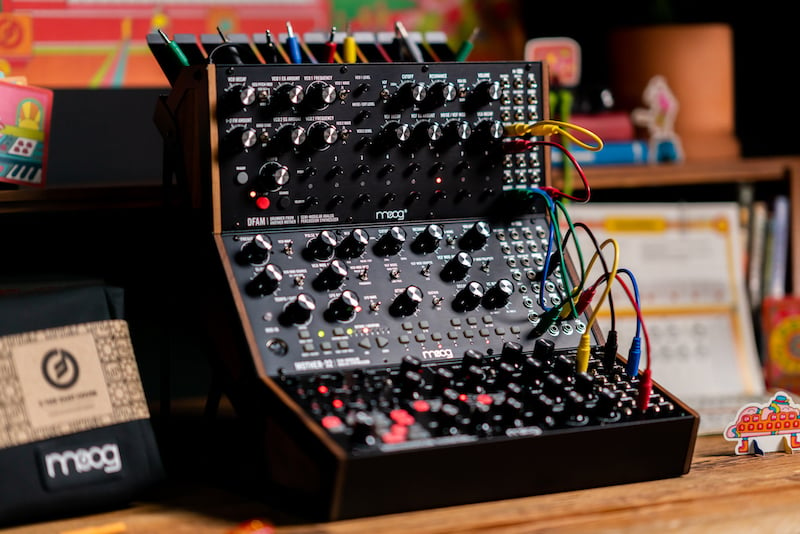
Mavis is a straight-to-the-point, all-analog semi-modular synth with an astonishing level of flexibility for its size and price. It'll make an excellent addition to any other semi-modular or modular setup...but at the same time, it would make an excellent first step for anyone completely new to the realm of modular synthesis. If you've been curious about dipping your toes into the modular universe and want an instrument that will teach you a lot and remain relevant as you expand, I strongly recommend Mavis.
Mother-32 is a classic synth ideal for keyboardists, or anyone looking for a bass and lead machine. If you want a classic Moog voice with a built-in sequencer and MIDI capability, Mother-32 is solid. DFAM is a percussion synth/sequencer designed for exploring rhythm and classic analog sound design. Subharmonicon, on the other hand, is an exploratory oddball, perfect for diving into experimental harmony and generative sequencing. Labyrinth uses an experimental-leaning sound structure quite different from its peers, and similarly uses an unpredictable (yet tameable!) sequencing strucutre; so it is perhaps best used by musicians looking to be surprised by their instrument, who value access to gritty and unusual timbres. Spectravox is quite different from the others, with a more specific set of use cases: it's great if you want a simple analog vocoder or a unique way of processing external signals.
Once you start to combine these instruments, you'll start to discover just how well they can complement one another. You can use the Sample + Hold from your Mavis to control the FM amount on your DFAM, or your DFAM's sequencer to generate harmonies on your Subharmonicon...or use your Subharmonicon's peculiar rhythm sequencer to modulate various parameters of your Mavis.
That's the beauty of modular synths in general: when you add a new piece of gear to your arsenal, it's not just about learning how that new piece of gear fits into your extant workflow. Instead, it's about adding new context to all of the instruments that you already know and love, and finding how adding one simple piece can suddenly transform the gear you already have. So, if you're ready to take a step into the world of modular synths—a world of constant discovery and re-discovery—then starting with one of these Moog synths could be a tremendously rewarding first step.

